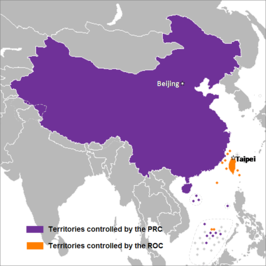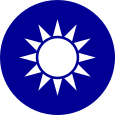
Back سياسة الصينيتان Arabic Два Китая Bulgarian Dos Chinas Spanish Deux Chines French Lióng ke Chûng-koet HAK Dua Tiongkok ID 二つの中国 Japanese 두 개의 중국 Korean Controversiae duarum civitatum Sinicarum Latin Dua China Malay
This article needs additional citations for verification. (February 2021) |
| Two Chinas | |||||||||||||
|---|---|---|---|---|---|---|---|---|---|---|---|---|---|
 Territories controlled by the People's Republic of China (PRC) (purple) and the Republic of China (ROC) (orange). The size of minor islands controlled by the PRC, the ROC, and other countries (gray) has been exaggerated in this map for ease of identification. | |||||||||||||
| Traditional Chinese | 兩個中國 | ||||||||||||
| Simplified Chinese | 两个中国 | ||||||||||||
| |||||||||||||
 |
|---|
|
|
 |
|---|
|
|
The term "Two Chinas" refers to the geopolitical situation where two political entities exist under the name "China".[1][2]
| Official name(s) | ||
|---|---|---|
| Common name | China | Taiwan (present) China (historical) |
| Date of establishment | 1 August 1927 7 November 1931 1 October 1949 |
1 January 1912 |
| Effective jurisdiction | Fujian, Jiangxi, Hunan and Jiangsu Soviet Zones (1927–1934) Shaanxi and Manchuria (1935–present) Mainland China (1949–present) Tibet and Chamdo (1951–present) Hong Kong (1997–present) Macau (1999–present) |
Mainland China (1912–1949) Tibet and Chamdo (1912–1951) Outer Mongolia (1919–1921) Taiwan and Pescadores (1945–present) Kinmen and Matsu Islands (1912–present)[3] |
| Representation of "China" in the United Nations |
1971–present | 1945–1971 |
| Capital | Jinggangshan (1927–1930) Ruijin (1931–1934) Zhidan (1935) Yan'an (1936–1947) Xibaipo (1947–1949) Beijing (1949–present) |
Nanjing (1912, 1927–1937, 1946–1949) Beijing (1912–1928) Chongqing (1937–1946, 1949) Guangzhou (1949) |
| Founder | Mao Zedong | Sun Yat-sen |
| Incumbent head of state | Xi Jinping | Tsai Ing-wen |
| Incumbent head of government | Li Qiang | Chen Chien-jen |
- ^ Gayner, Jeffrey B (2 July 1977). "U.S. Diplomacy and the Two Chinas". Archived from the original on 18 January 2021. Retrieved 19 March 2021.
- ^ Swift, John (2003). "The Two Chinas". The Palgrave Concise Historical Atlas of the Cold War. pp. 44–45. doi:10.1057/9780230001183_20. ISBN 978-0-333-99404-7. Archived from the original on 2023-04-11. Retrieved 2021-02-11.
- ^ "At the Edge of State Control: The Creation of the "Matsu Islands"". Taiwan Insight. University of Nottingham Taiwan Studies Programme. 2021-09-13. Retrieved 2023-05-21.
Taiwan was a colony of Japan, whereas Matsu was part of Fujian
© MMXXIII Rich X Search. We shall prevail. All rights reserved. Rich X Search
